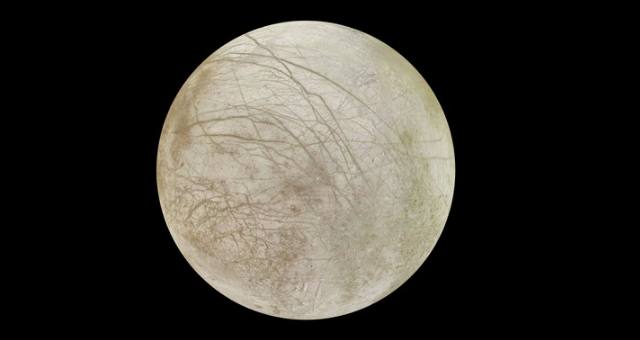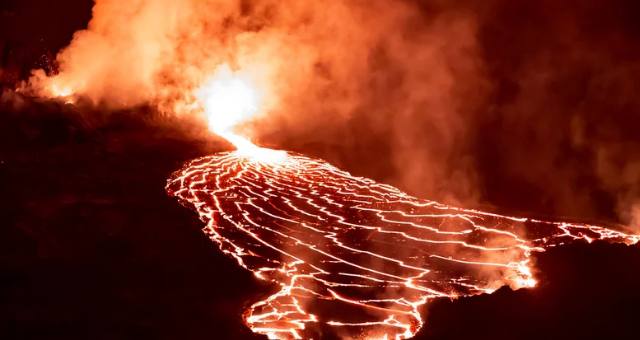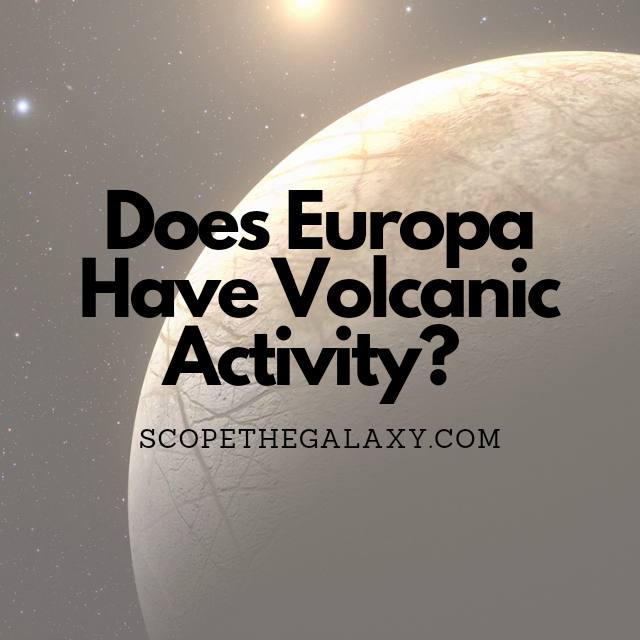*This post may contain affiliate links. This means we may make a commission if you purchase an item using one of our links*
Jupiter’s moon, Europa, is roughly 90% the size of Earth’s moon but far, far brighter. This is because the distant world of Europa is a giant ball of ice. Still, scientists believe this moon could have a similar composition to Earth, and that heat and friction internally could cause icy lava plumes to erupt from the planet.
Continue reading to discover why scientists believe Europa has volcanic activity, why these features could support life, and when we expect evidence of these features.
Is Europa The Most Volcanically Active Moon?
Table of Contents

Europe is one of the four Galilean moons of Jupiter, first discovered in 1610. It has risen to prominence in recent years thanks to scientific theories that it could host life.
Observations from Earth’s telescopes show that this distant moon is wrapped in an icy shell. Experts have reason to believe that beneath this solid exterior, there could be a liquid water ocean – or one composed of slushy ice. Either way, if Europa does have liquid water, then it could host life.
Current scientific estimates calculate the crust to be between 15-25 km thick. In comparison, the ocean beneath could stretch to depths of 150 km. This would mean that even though Europa is only a quarter of our size, it could contain twice as much water as all of our oceans combined.
And these ocean depths are where scientists believe volcanoes could reside. At first glance, this icy world may look like the last place you’d find volcanic activity, but computer models demonstrate how internal heat (generated by tidal movement) could partially melt the rocky inner layer and feed volcanoes lying on the ocean floor.
Still, even with this possibility for volcanic activity, Europa is not the most volcanically active moon in our solar system. That title falls to Io, another of Jupiter’s Galilean moons that has hundreds of active volcanoes on its surface, some shooting lava fountains dozens of kilometers into the sky.
These volcanoes are different from the ones found on Earth; they are created thanks to Io’s proximity to Jupiter and the powerful gravity that comes from this gas giant, causing Io to squeeze and flex.
Io is 422,000 km from Jupiter, while Europa is a greater distance of 670,900 km from the planet. Still, it could be close enough for the giant mass of Jupiter to create active volcanoes.
How Many Volcanoes Are There On Europa?
Computer simulations of Europa suggest that it could have a similar composition to Earth, with a saltwater ocean, rocky mantle, and iron core. A team of scientists led by Marie Behounkova used this model to help determine Jupiter’s pull on the interior of Europa.
This flexing concentrates energy into the moon’s interior, where it can seep out as heat. Models show that heat dissipates in higher concentrations are the poles where tidal friction is most significant. And this friction and heat could cause areas of the rocky mantle to melt, thereby increasing the likelihood of moons on Europa.
These volcanoes could also increase the likelihood that Europa is a host to life. Our seafloor is littered with volcanic vents that allow life to thrive. This is because these volcanic vents can provide chemical energy in deep ocean areas (where the Sun cannot reach).
Still, Europa’s volcanoes are hypothetical, and we will only know definitive answers once we collect more data.
In 2024, the Europa Clipper is scheduled to depart Earth and make a six-year journey to Jupiter, where it will conduct repeated flybys of Europa to analyze the surface and look for any sign of water plumes or ejected particles. Plus, the mission will be able to measure any anomalies in gravity and magnetism around the poles, which could give more clues to volcanic activity hiding beneath the surface.
Is There Lava On Europa?

We can only say for sure whether there is lava (or even volcanoes) on Europa once scientists have collected more data. Still, some experts suggest that the Europa Clipper mission could spot shallow lakes that erupt a kind of icy form of lava.
These icy plumes, known as “cryolava,” would be Europa’s equivalent to the molten lava we see on Earth. And computer models suggest that these lava eruptions could stem from subsurface lakes in Europa’s crust rather than from its vast ocean.
This is because water held within 4-8 km of the moon’s surface would sit at the coldest and most volatile point. Therefore, water at this depth would be more likely to freeze and expand, triggering an explosion. The exciting news is that the Europa Clipper should have suitable tools for exploring the moon at this depth and providing us with some definitive answers in the 2030s.
Summary
Computer modeling suggests a likely possibility that Europa could contain several volcanoes beneath its icy surface – if it does, this could provide an even better environment for this distant world to support life. Still, we’ll have to wait a little longer for the Europa Clipper mission to probe this faraway moon and provide more definitive answers.
References
In-Depth | Europa – NASA Solar System Exploration
Active seafloor volcanoes on Jupiter’s moon Europa? (earthsky.org)
Europa Clipper may be able to spot shallow lakes that erupt | Space
In-Depth | Io – NASA Solar System Exploration

